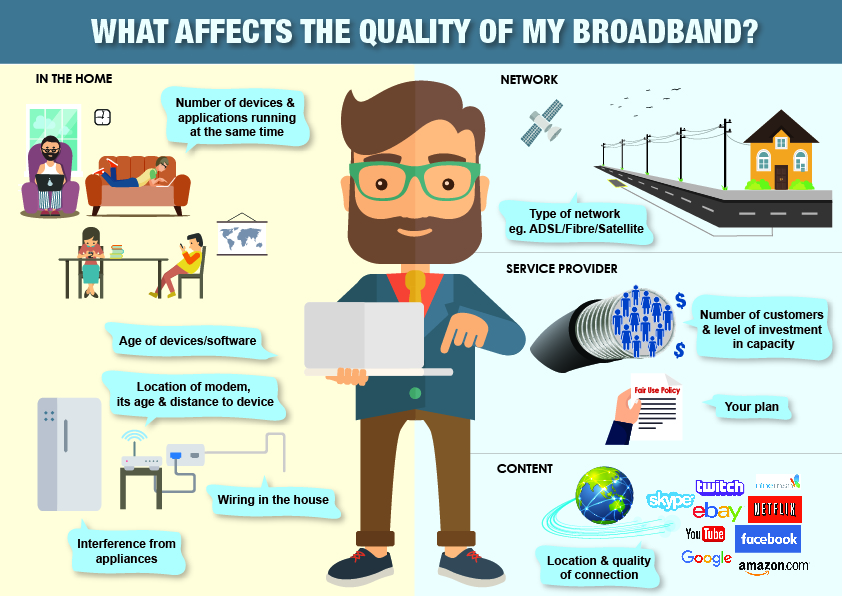Download: ![]() What affects the quality of my broadband brochure40.75 KB
What affects the quality of my broadband brochure40.75 KB
Download: ![]() What affects the quality of my broadband brochure404.28 KB
What affects the quality of my broadband brochure404.28 KB
Hello...hello...can you hear me..?
Is poor internet preventing you from talking with family and friends, watching your favourite shows or uploading photos of your recent adventures to share with everybody?
Poor internet quality can cause much frustration and trying to figure out the cause of the issue can be even more annoying. The internet is complex and there are many stages data has to go through to get to and from you. Problems can occur with each stage. Some of these you have control over and may be able to solve, while others you might not.
Our infographic summarises the factors that can affect your broadband connection. For more information, read ACCAN's overview below of some of the problems that make internet connections low quality and slow.
In the home
Who uses the connection and how it is used
The type and number of devices being used, and the number of webpages and applications open will affect the performance and speed experienced. If lots of devices and people are trying to access information, then the connection will be shared between all these requests, which may affect the performance.
The internet connection
The router and modem used in the home can affect the performance of the broadband connection. If Wi-Fi is being used then the location of the equipment may affect the performance. The closer the router is to the computer the better the performance is likely to be. Walls, ceilings and floors may affect the signal, especially in some older buildings. Your Wi-Fi signal might have some interference problems if it is located near other objects, for example your neighbours' modem or beside other household electronics, such as fridges or microwaves. Playing around with the location of equipment or plugging devices into the modem via a cable might improve the performance.
Upgrades
Some hardware and software (i.e. modems, routers, tablets, and laptops) isn't designed for very fast data transfer and this may limit the performance experienced. Older equipment and devices may not run as efficiently and could be slowing down your broadband connection. Purchasing newer equipment or upgrading software may improve performance.
The wiring in the home
The wiring in the home can also cause poor performing broadband and voice services. A retail provider or an electrician can test the wiring and recommend any changes that are required.
Service Provider (for example Telstra, Optus, TPG)
Plans and rules
Many providers sell plans offering speeds up to a certain level, but these may not be attainable for all customers. Retailers should not mislead consumers regarding the speeds that the network, its plans and the equipment it provides can achieve.
Furthermore, as part of the rules of the plan the provider might deliberately slow down the internet. For example, if you use up your monthly data allowance then your provider might limit the speed that you can receive. This is called shaping or throttling.
Investment in the network
Each provider balances the cost of providing services with investing in its services. Providers may choose to invest less than is required for the number of customers using the service or to deal with potential network faults; this is called under-provisioning. Lower investments may result in a lower quality service.
For example the internet may be noticeably slower when trying to access the internet at peak times when lots of customers are online. Some providers offer faster and more reliable services than others. But it's not easy to identify which providers offer better performance. Your choice of provider might be affecting your performance. Switching providers may improve your service.
Network (for example ADSL, Fibre or Satellite provided by Telstra, NBN etc.)
The network can also affect the performance received. Different network technologies have different speed and performance capabilities. Network providers make choices about how the network functions. This is similar to building motorways, where decisions are made on how many lanes are required (capacity) and the route to take. If the network is not able to deal with all the requests or is too far from your premises (distance from the exchange) then the service is likely to be slow.
Content
The internet is made up of tens of thousands of separate networks. The size of the content being looked at, where the information is located and how good the end-to-end network connection is between the content and the consumer can affect both how long it takes to get to a consumers' home as well as the quality received. For example, information that is stored in another country has to travel a long distance. This can mean that at times some websites will appear slow whilst others may be working just fine. Furthermore, content providers (such as Twitch or Netflix) can manage the performance of their services by the quality of investment they put into the delivery of the service.
Further help
If you are experiencing slow internet it can be very difficult to identify what is causing the problem. If you are experiencing problems or contemplating purchasing a new or alternative internet service, visit the Your Internet and Home Phone Talking Telco guides.

